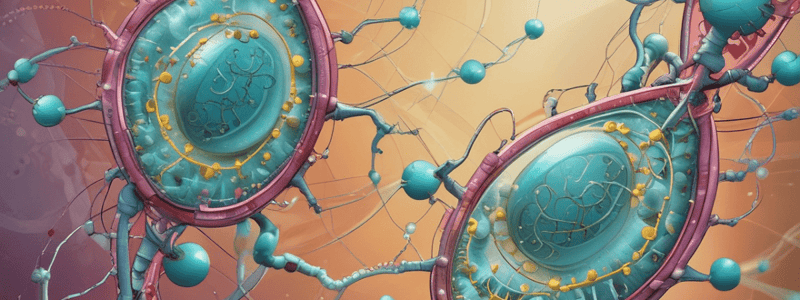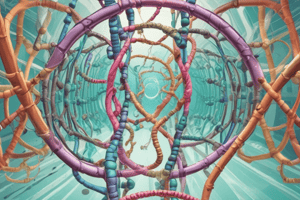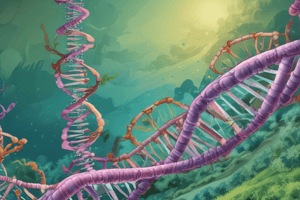Podcast
Questions and Answers
Which step is NOT part of the genetic engineering process?
Which step is NOT part of the genetic engineering process?
- Cutting
- Isolation
- Transformation
- Amplification (correct)
How does genetic engineering enhance crop resistance?
How does genetic engineering enhance crop resistance?
- By introducing a bacterial gene for weed killer resistance (correct)
- By modifying their growth conditions
- Through traditional breeding methods
- By altering environmental factors
What is a notable outcome of inserting a human gene into sheep DNA?
What is a notable outcome of inserting a human gene into sheep DNA?
- Sheep can live longer due to improved health
- Sheep produce a protein for treating emphysema in their milk (correct)
- Sheep produce wool with medicinal properties
- Sheep become resistant to common diseases
Which application of genetic engineering is used for insulin production?
Which application of genetic engineering is used for insulin production?
Which of the following statements about genetic engineering is incorrect?
Which of the following statements about genetic engineering is incorrect?
What process follows the cutting of a gene in genetic engineering?
What process follows the cutting of a gene in genetic engineering?
What is a potential application of genetic engineering to livestock?
What is a potential application of genetic engineering to livestock?
Which of the following steps is involved in the genetic engineering of microorganisms?
Which of the following steps is involved in the genetic engineering of microorganisms?
Which of these statements best represents a benefit of genetic engineering in crops?
Which of these statements best represents a benefit of genetic engineering in crops?
What is the primary aim of the transformation step in genetic engineering?
What is the primary aim of the transformation step in genetic engineering?
What is a primary goal of ligation in the genetic engineering process?
What is a primary goal of ligation in the genetic engineering process?
Which of the following organisms commonly utilizes the genetic engineering technique for the purpose of producing human insulin?
Which of the following organisms commonly utilizes the genetic engineering technique for the purpose of producing human insulin?
Which genetic engineering application enhances plants' resistance to herbicides?
Which genetic engineering application enhances plants' resistance to herbicides?
Which step directly follows the cutting of a gene in the genetic engineering sequence?
Which step directly follows the cutting of a gene in the genetic engineering sequence?
What is a significant outcome of inserting a human gene into sheep DNA?
What is a significant outcome of inserting a human gene into sheep DNA?
Flashcards are hidden until you start studying
Study Notes
Genetic Engineering Overview
- Genetic engineering involves the deliberate modification of an organism's DNA.
- This biotechnological process allows for the alteration of genetic material to achieve desirable traits or characteristics.
Steps of Genetic Engineering
- Isolation: Extracting the gene of interest from the organism.
- Cutting: Using restriction enzymes to cut both the isolated gene and the target DNA at specific sites.
- Ligation: Joining the DNA fragment of interest with the target DNA using ligase enzymes.
- Transformation: Introducing the new DNA into a host organism, such as bacteria, plants, or animals.
- Cloning: Replicating the transformed organism to produce multiple copies containing the desired gene.
- Expression: Activating the inserted gene to produce the intended protein or trait.
Applications in Plants
- Certain crop plants have been genetically modified to incorporate a bacterial gene for herbicide resistance, allowing them to survive applications of weed killers.
Applications in Animals
- Genetic engineering enables the insertion of a human gene into sheep DNA, facilitating the production of therapeutic proteins in sheep's milk, which can be utilized for treating conditions such as emphysema.
Applications in Micro-organisms
- The gene coding for human insulin can be inserted into bacteria, resulting in the bacteria producing significant quantities of insulin for medical use, addressing diabetes treatment needs.
Genetic Engineering Overview
- Genetic engineering involves the deliberate modification of an organism's DNA.
- This biotechnological process allows for the alteration of genetic material to achieve desirable traits or characteristics.
Steps of Genetic Engineering
- Isolation: Extracting the gene of interest from the organism.
- Cutting: Using restriction enzymes to cut both the isolated gene and the target DNA at specific sites.
- Ligation: Joining the DNA fragment of interest with the target DNA using ligase enzymes.
- Transformation: Introducing the new DNA into a host organism, such as bacteria, plants, or animals.
- Cloning: Replicating the transformed organism to produce multiple copies containing the desired gene.
- Expression: Activating the inserted gene to produce the intended protein or trait.
Applications in Plants
- Certain crop plants have been genetically modified to incorporate a bacterial gene for herbicide resistance, allowing them to survive applications of weed killers.
Applications in Animals
- Genetic engineering enables the insertion of a human gene into sheep DNA, facilitating the production of therapeutic proteins in sheep's milk, which can be utilized for treating conditions such as emphysema.
Applications in Micro-organisms
- The gene coding for human insulin can be inserted into bacteria, resulting in the bacteria producing significant quantities of insulin for medical use, addressing diabetes treatment needs.
Genetic Engineering Overview
- Genetic engineering involves the deliberate modification of an organism's DNA.
- This biotechnological process allows for the alteration of genetic material to achieve desirable traits or characteristics.
Steps of Genetic Engineering
- Isolation: Extracting the gene of interest from the organism.
- Cutting: Using restriction enzymes to cut both the isolated gene and the target DNA at specific sites.
- Ligation: Joining the DNA fragment of interest with the target DNA using ligase enzymes.
- Transformation: Introducing the new DNA into a host organism, such as bacteria, plants, or animals.
- Cloning: Replicating the transformed organism to produce multiple copies containing the desired gene.
- Expression: Activating the inserted gene to produce the intended protein or trait.
Applications in Plants
- Certain crop plants have been genetically modified to incorporate a bacterial gene for herbicide resistance, allowing them to survive applications of weed killers.
Applications in Animals
- Genetic engineering enables the insertion of a human gene into sheep DNA, facilitating the production of therapeutic proteins in sheep's milk, which can be utilized for treating conditions such as emphysema.
Applications in Micro-organisms
- The gene coding for human insulin can be inserted into bacteria, resulting in the bacteria producing significant quantities of insulin for medical use, addressing diabetes treatment needs.
Studying That Suits You
Use AI to generate personalized quizzes and flashcards to suit your learning preferences.




